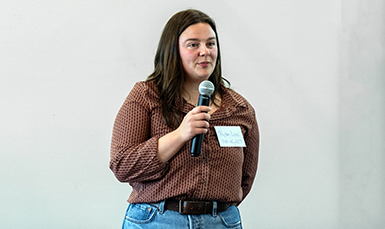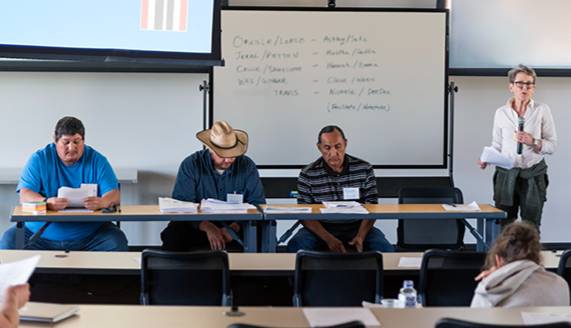
Cattle, Hay, and Water: The Wind River Agriculture & Water Symposium
Published June 05, 2025
By Peyton Loss

Peyton Loss presenting at the Agriculture & Water Symposium
Wyomingites are resilient. In a place where the weather tests your grit and neighbors look out for each other, people know how to face challenges head-on. This spirit of adaptation and resilience was front and center at the recent Wind River Agriculture & Water Symposium; an event focused on water and agriculture, and brought together ranchers, scientists, students, artists, and community members in an empowering exchange of knowledge.
The Symposium was organized by the University of Wyoming’s WyACT project, the Wind River Water Resources Control Board, a tribal steering committee, and Central Wyoming College. Attendees learned about the Wind River Agricultural Resource Management Plan and Wind River Water Code – two vital tools that were developed by the Eastern Shoshone and Northern Arapaho Tribes to guide collaborative agricultural and water resource management on the Wind River Indian Reservation.
Water is everything
In Wyoming, where semi-arid grasslands and shrublands stretch across most of the state and irrigated croplands cover just a small portion, water is everything. Ranchers know this better than anyone. As snowfall and precipitation patterns change, so does water availability, putting rangeland forage and irrigated hay production at risk. The fifth driest state in the nation, Wyoming annually receives only about 13 inches of precipitation. With such a limited water supply, what happens when precipitation patterns change? What do ranchers do when the water they rely on becomes less predictable?
Cattle and hay are not just staples of Wyoming’s landscape; they are economic cornerstones woven into the fabric of Wyoming’s rural communities. In 2021, cattle production contributed over $1.1 billion to the state’s economy, while hay production added another $220 million. Ranchers depend on the land, and rural communities depend on ranchers – not only for beef and hay, but for vibrant small-town economies, local jobs, and a way of life that defines the Cowboy State.
Research supports ranchers

from left: Lokilo St. Clair, Jerel Kohler, Travis Shakespeare and Mary Keller
Through workshops, research presentations, and community conversations, the Symposium emphasizes a simple but powerful idea: when communities are equipped with place-based education and science, they are better prepared to face an uncertain future. As neighbors gather to share ideas and solutions, they strengthen the social fabric that supports Wyoming’s ranchers and rural communities. This preparation could make all the difference as communities look to the future and navigate the challenges of changing water resources in order to continue thriving on the landscapes they know best.
